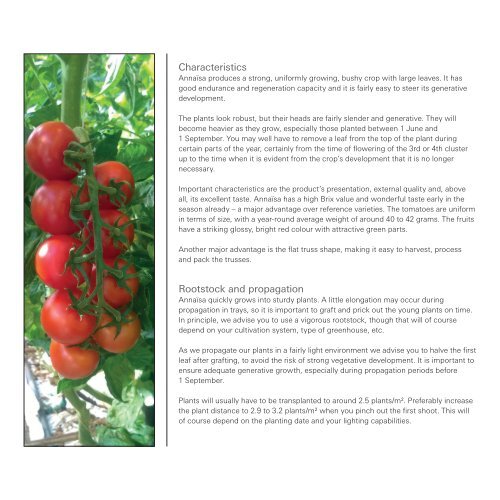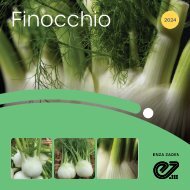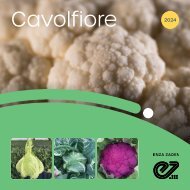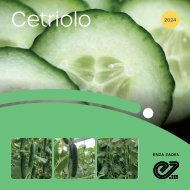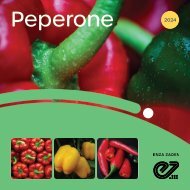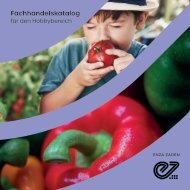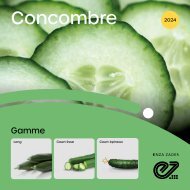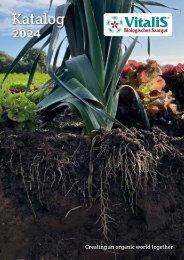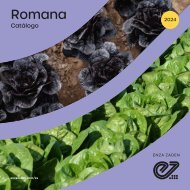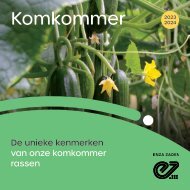Guidelines Annaïsa 2017
You also want an ePaper? Increase the reach of your titles
YUMPU automatically turns print PDFs into web optimized ePapers that Google loves.
Characteristics<br />
<strong>Annaïsa</strong> produces a strong, uniformly growing, bushy crop with large leaves. It has<br />
good endurance and regeneration capacity and it is fairly easy to steer its generative<br />
development.<br />
The plants look robust, but their heads are fairly slender and generative. They will<br />
become heavier as they grow, especially those planted between 1 June and<br />
1 September. You may well have to remove a leaf from the top of the plant during<br />
certain parts of the year, certainly from the time of flowering of the 3rd or 4th cluster<br />
up to the time when it is evident from the crop’s development that it is no longer<br />
necessary.<br />
Important characteristics are the product’s presentation, external quality and, above<br />
all, its excellent taste. <strong>Annaïsa</strong> has a high Brix value and wonderful taste early in the<br />
season already – a major advantage over reference varieties. The tomatoes are uniform<br />
in terms of size, with a year-round average weight of around 40 to 42 grams. The fruits<br />
have a striking glossy, bright red colour with attractive green parts.<br />
Another major advantage is the flat truss shape, making it easy to harvest, process<br />
and pack the trusses.<br />
Rootstock and propagation<br />
<strong>Annaïsa</strong> quickly grows into sturdy plants. A little elongation may occur during<br />
propagation in trays, so it is important to graft and prick out the young plants on time.<br />
In principle, we advise you to use a vigorous rootstock, though that will of course<br />
depend on your cultivation system, type of greenhouse, etc.<br />
As we propagate our plants in a fairly light environment we advise you to halve the first<br />
leaf after grafting, to avoid the risk of strong vegetative development. It is important to<br />
ensure adequate generative growth, especially during propagation periods before<br />
1 September.<br />
Plants will usually have to be transplanted to around 2.5 plants/m². Preferably increase<br />
the plant distance to 2.9 to 3.2 plants/m² when you pinch out the first shoot. This will<br />
of course depend on the planting date and your lighting capabilities.<br />
Start of the season<br />
We advise that you start with a slab EC of 3.8–4.0 mS/cm. In practice, conditions are<br />
sometimes controlled for 3 to 6 days after the planting, but we advise you not to do<br />
that. Conditions immediately after planting will often be warm and light; root growth<br />
and water absorption must not be hindered in any way during this phase.<br />
Climate<br />
Ensure high 24-hour temperatures, if possible with a day/night difference of 5 ˚C to<br />
7 ˚C, from the second day after planting to promote generative development and the<br />
formation of well-balanced plants. This may be difficult to realise in crops planted<br />
between 1 April and mid-September, when surplus light may restrict your options.<br />
This will also be the case with crops planted after mid-September, but more important<br />
with these crops will be to ensure humidity is adequately controlled. <strong>Annaïsa</strong> needs<br />
an airy climate promoting an active crop.<br />
We tend to regard the thicker stems and long, large leaves of plants planted after<br />
20 September as “vegetative”. In the case of <strong>Annaïsa</strong> we advise you to accept the<br />
large size of your plants around the time of the formation of trusses 5 or 6 (depending<br />
on the planting date) and to focus solely on the quality of the clusters. You may well<br />
have to lower the 24-hour temperatures earlier than you’d think. If you continue with<br />
high 24-hour temperatures for too long in the hope of obtaining “slender” plants<br />
you will often end up with weak trusses of tomatoes with a (too) low weight in late<br />
December and January.<br />
It is important with this variety to ensure an airy climate and an active crop, to<br />
gradually raise the temperature to the day value and to ensure sufficient humidity<br />
control (but without having to take extreme measures). You must – literally – invest<br />
enough energy in it.<br />
An early morning temperature of 17 ˚C-18 ˚C (+0.5 ˚C light) will usually suffice. If the<br />
crop’s temperature is too high early in the morning you will have to vent close to<br />
the heating temperature. Venting, and a climate promoting an active crop are your<br />
most important tools in the first cultivation phase. But don’t overdo things, because<br />
too much venting causing the greenhouse temperature to drop too much will<br />
involve a risk of cold heads and leaf margins. Invest sufficient energy in heating your<br />
greenhouse to promote active plant development. Raise the temperature slowly to the<br />
daytime value on days with low outdoor light intensities.


